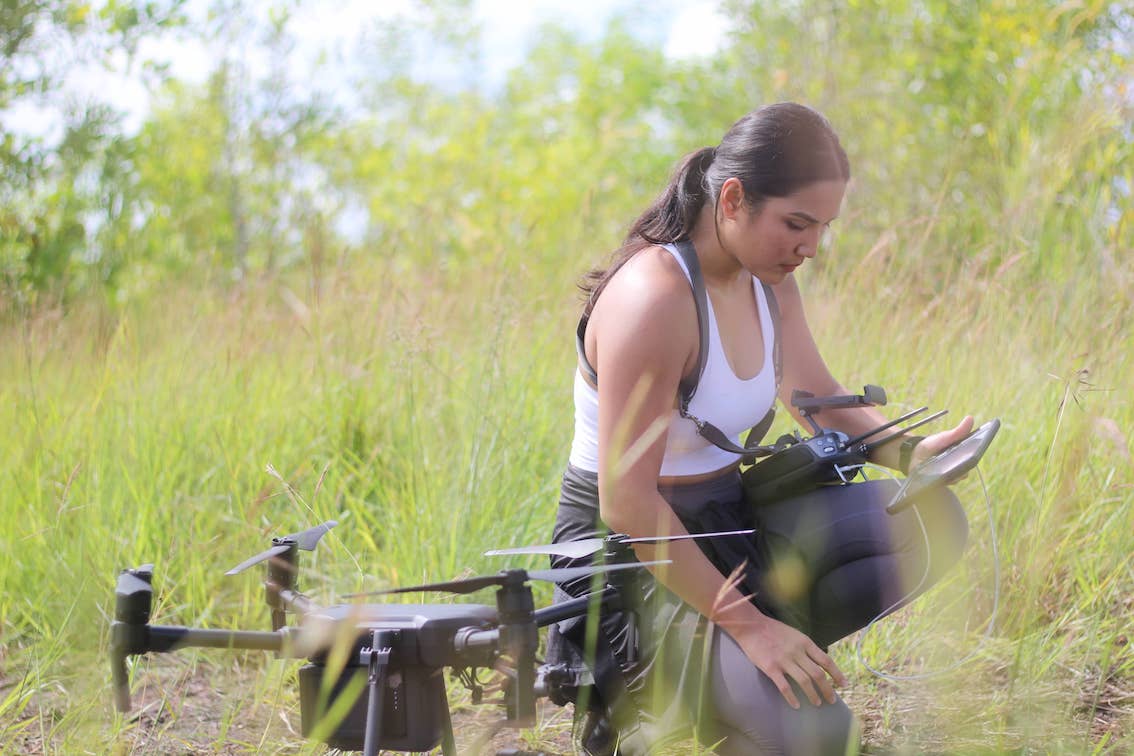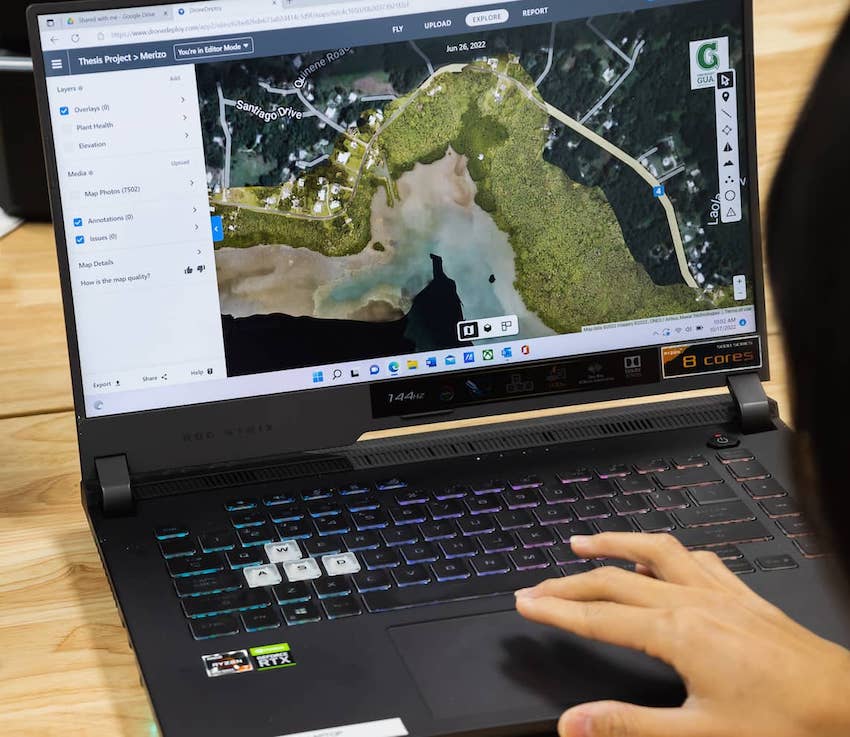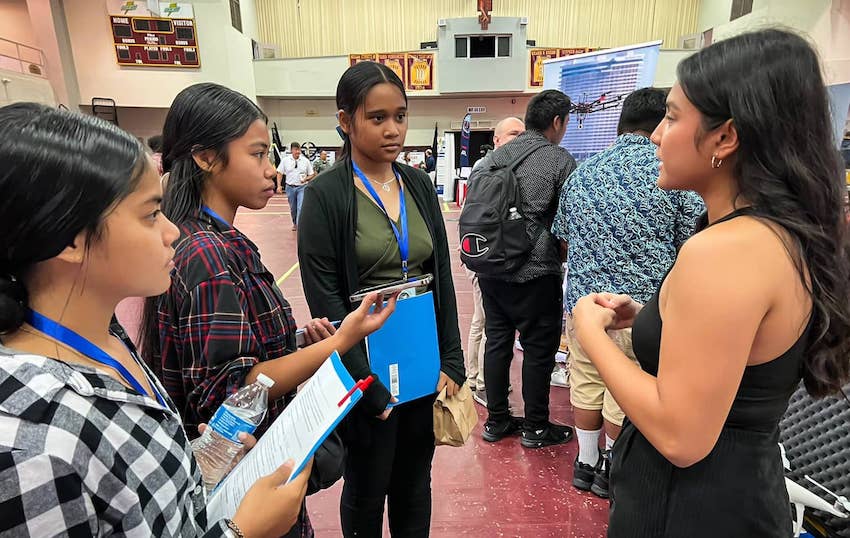- Home
-
Admissions
-
Academics
-
Students
-
Research
-
Research Centers
- Cancer Research Center
- Center for Excellence in Development Disabilities Education, Research & Service (CEDDERS)
- Center for Island Sustainability (CIS)
- Marine Laboratory
- Micronesian Area Research Center (MARC)
- UOG Land Grant | agInnovation Research Center
- Water and Environmental Research Institute (WERI)
-
Programs and Departments
- Guam EPSCOR
- Guma' Tinemtom - Micronesia Data Laboratory
- Pacific Islands Climate Adaptation Science Center (PI-CASC)
- Pacific Islands Cohort on Cardiometabolic Health (PICCAH)
- Research Corporation of UOG
- RFK Memorial Library
- UOG Press
- UOG Sea Grant
- University Libraries Digital Team
- NASA Guam Space Grant
- NASA Guam EPSCoR
-
Research Centers
-
Outreach
- Giving
- Alumni
-
About
Above water: UOG student uses drones to study mangroves and reefs
Above water: UOG student uses drones to study mangroves and reefs
Above water: UOG student uses drones to study mangroves and reefs
11/4/2022

When it comes to understanding our island’s water features, one might launch a boat or dive in to get a closer look at what lies beneath the surface. But for Jonelle Sayama, there is also a lot of value to gain from a bird’s eye view.
“Drones have paved the way for making fieldwork more accessible to people, and that just advances the field of our natural sciences,” she said about the research benefits of unmanned aerial vehicles (UAVs), or drones.
“I think that any type of monitoring, like trying to get visuals in hard-to-reach areas, can be difficult. There are not many paths for it. Using drones has made this type of fieldwork totally accessible to people in that sense.”
After graduating from the University of Portland in 2020 with a bachelor’s degree in environmental science, Sayama returned home to Guam with no concrete plans for her post-graduate career.
Yet she knew that whatever she pursued, she needed to achieve at least two things: Giving back to her island environment, and spending more time in the field. That opportunity came in the form of a research project for the NASA Guam Space Grant Program at the University of Guam.
Sayama, who is pursuing a master’s degree in environmental science at UOG, is one of two graduate students so far to have been awarded a fellowship under the program. It offers fellowships and internships for college students to pursue research projects aligned with NASA’s goals in further understanding human exploration, the solar system, and the planet.
Under the mentorship of Romina King, associate director of NASA Guam Space Grant, Sayama is monitoring the health of Guam’s mangrove forests by mapping the often difficult-to-traverse ecosystems from above with drones.
These coastal areas, despite unstable conditions in their salinity, tides, and temperature, are among the island’s most important ecosystems in sustaining life on land and sea: protecting shorelines from erosion, filtering harmful chemicals between freshwater and saltwater, and providing a nursery ground for numerous marine species.
“Jonelle has been a stellar example of what a fellow can achieve when given the resources they need,” King said. “Her use of drones to help expand the knowledgebase of our island’s precious marine environments will prove valuable for the years to come."
By gathering various datasets from her aerial captures, including elevation information, plant health, and orthomosaic maps of the island’s mangroves, Sayama said she hopes to investigate whether these areas are doing better now in terms of growth density than when compared to earlier satellite data.
“Ultimately, the goal is to gain a better understanding of how our mangroves are doing because of their importance to our ecosystem, coastal health, and marine species,” Sayama said. “Gaining that better understanding is going to help us to prevent any further destruction and to help create laws in place to protect them.”
From freshwater to seawater

The first project, titled “Hånom Fresko yan Acho’ Tåsi,” or “Freshwater and Coral,” uses drones to assess the Northern Guam Lens Aquifer, which supplies almost 90% of the island’s drinking water, and produce critical data that can assist natural resource managers with the aquifer’s monitoring and care.
Funded by a grant awarded to NASA Guam EPSCoR, the project aims to produce maps of the aquifer’s freshwater discharge, provide a better estimate of its water supply, and look for relationships between that freshwater discharge and surrounding coral reef health.
The second project, also funded by NASA, is a joint field campaign between UOG and the University of Miami to create 3D images of coral reefs throughout the island. Co-led by Ved Chirayath and King, the mission uses drones and NASA Fluid Lensing technology to see beneath the waves and coral reefs with centimeter-scale accuracy.
Sayama co-leads a mission every two weeks to fly a drone over the Piti Bomb Holes marine preserve to monitor any long-term changes in the coral reefs. The final data will be used to help researchers and natural resource managers understand coral reef health, including information on rates of coral bleaching.
Sayama said experiencing these precious marine habitats is among the most fulfilling and exhilarating parts of her research work.
“I think that on Guam, we have a good understanding of the connection between our environment, our water resources, and our livelihoods,” she said. “And that by really putting yourself out there, doing these types of research projects, you gain a more physical understanding of it, rather than just hearing about it. We’re seeing it and we’re experiencing it.”
A daunting shift made exciting through mentorship

From there, Sayama took an online preparation course and became a licensed remote pilot in four months.
Sayama now serves as a mentor for the UOG Drone Corps.
For students who would like to become licensed drone pilots, the UOG Drone Corps program is expected to open applications next Spring. Go to www.bit.ly/dronecorps for more information.
Additionally, the NASA Guam Space Grant welcomes applications for its internship and fellowship programs. Interested students can visit www.uog.edu/nasa-guam-space-grant or contact Keanno Fausto at faustok9679@triton.uog.edu
